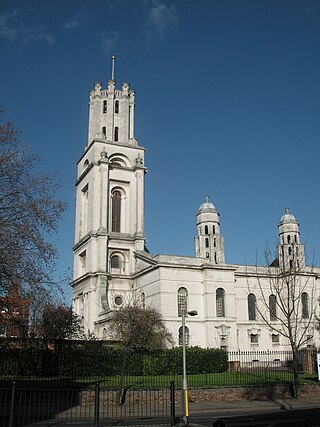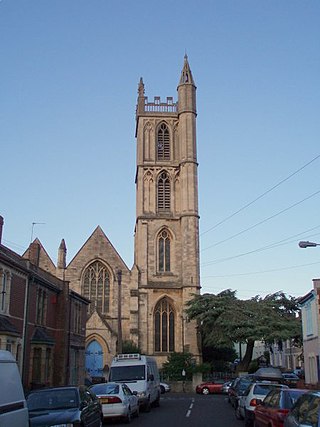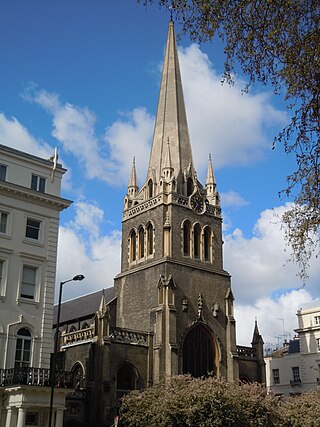
St Mary Redcliffe is an Anglican parish church located in the Redcliffe district of Bristol, England. The church is a short walk from Bristol Temple Meads station. The church building was constructed from the 12th to the 15th centuries, and it has been a place of Christian worship for over 900 years. The church is renowned for the beauty of its Gothic architecture and is classed as a Grade I listed building by Historic England. It was famously described by Queen Elizabeth I as "the fairest, goodliest, and most famous parish church in England."

The Cathedral Church of Saint Michael, commonly known as Coventry Cathedral, is the seat of the Bishop of Coventry and the Diocese of Coventry within the Church of England. The cathedral is located in Coventry, West Midlands, England. The current bishop is Christopher Cocksworth and the current dean is John Witcombe.

St George-in-the-East is an Anglican Church dedicated to Saint George; located on Cannon Street Road, between The Highway and Cable Street, in the East End of London. Behind the church lies St George's Gardens, the original graveyard.

St Mary le Port is a ruined parish church in the centre of Bristol, England, situated in Castle Park on what remains of Mary le Port Street.

The Priory Church of St James, Bristol, is a Grade I listed building in Horsefair, Whitson Street.

Castle Park is a public open space in Bristol, England, managed by Bristol City Council. It is bounded by the Floating Harbour and Castle Street to the south, Lower Castle Street to the east, and Broad Weir, Newgate and Wine Street to the north. Its western boundary is less obviously defined and has been the subject of controversy, perhaps because the area around High Street and St Mary le Port Church, though not part of the park and always intended for development, is often considered at the same time as the park.

Temple Church, also known as Holy Cross Church, is a ruined church in Redcliffe, Bristol, England. It is on the site of a previous, round church of the Knights Templar, which they built on land granted to them in the second quarter of the 12th century by Robert of Gloucester. In 1313 the Knights Hospitaller acquired the church, following the suppression of the Templars, only to lose it in 1540 at the time of the Dissolution of the Monasteries. By the early 14th century, the church served as the parish church for the area known as Temple Fee. From around the same time, the rebuilding of the church on a rectangular plan started. This was completed by 1460, with the construction of a leaning west tower.

The Bristol Blitz was the heavy bombing of Bristol, England by the Nazi German Luftwaffe during the Second World War. Due to the presence of Bristol Harbour and the Bristol Aeroplane Company, the city was a target for bombing and was easily found as enemy bombers were able to trace a course up the River Avon from Avonmouth using reflected moonlight on the waters into the heart of the city. Bristol was the fifth-most heavily-bombed British city of the war.

St John on the Wall in Bristol is a historic church in the care of heritage charity The Churches Conservation Trust. The upper church and its medieval vaulted crypt is located at the lower end of Broad Street and is built into the old city's medieval walls.

Holy Trinity Church, Kingswood, is an Anglican parish church in Kingswood, South Gloucestershire, England. It has been designated as a grade II* listed building.

SS Philip and Jacob Church, previously referred to as Pip 'n' Jay, is a parish church in central Bristol, England. The church that meets there is now called Central. Its full name since 1934 is St Philip and St Jacob with Emmanuel the Unity, although reference to the original church of St Philip exists in records dating from 1174. Historically the 'Mother church of East Bristol', it serves the area known as The Dings.

Church of Holy Trinity is an Anglican church in Hotwells, Bristol, England. It has been designated as a grade II* listed building.

St Mary the Virgin is a Church of England parish church in Henbury, Bristol, England.

The Mount Without was a church now a creative space on St Michael's Hill in Bristol, England, near the University. It has been designated as a grade II* listed building, and was described as being in poor condition and on the Buildings at Risk Register.

St Nicholas is a church in St Nicholas Street, Bristol, England. The church was bombed in the Second World War and rebuilt in 1974–1975 as a church museum. This museum closed in 2007 and the building was used by the city council as offices; in 2018 the church came back into use as an Anglican place of worship in the Diocese of Bristol.

St Thomas the Martyr is a former Church of England parish church on St Thomas Street in the Redcliffe district of the English port city of Bristol.

St Wilfrid's Church stands to the north of the village of Mobberley, Cheshire, England. The church is recorded in the National Heritage List for England as a designated Grade I listed building. It is an active Anglican parish church in the diocese of Chester, the archdeaconry of Macclesfield and the deanery of Knutsford. Alec Clifton-Taylor includes it in his list of 'best' English parish churches.

St Werburgh's Church, Bristol, is a former church, now a climbing centre in the St Werburghs area of central north-east Bristol, England. It has been designated on the National Heritage List for England as a Grade II* listed building.

All Saints' Church, also known as Lydd Church or The Cathedral on the Marsh, is a church in Lydd, Kent, South East England. It belongs to the Diocese of Canterbury. All Saints is the longest parish church in Kent at 199 feet (61 m), and also has one of the tallest towers in the county at 132 feet (40 m). The church is thought to incorporate a small Romano-British basilica possibly built in the 5th century, though most of the current fabric is medieval. It was associated with local fraternities or guilds in the 15th century and could seat 1,000 people at a time. Severely damaged by World War II bombing, the church was subsequently restored and is now a Grade I listed building.

St James' Church Paddington, also known as St James' Church Sussex Gardens, is a Church of England parish church in Paddington, London, in the United Kingdom. It is the parish church of Paddington. It is located at the western end of Sussex Gardens, a long tree-lined avenue, about 175 metres (0.109 mi) north of Hyde Park.























